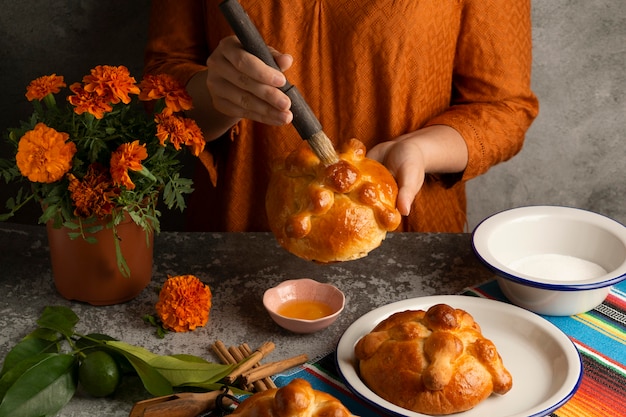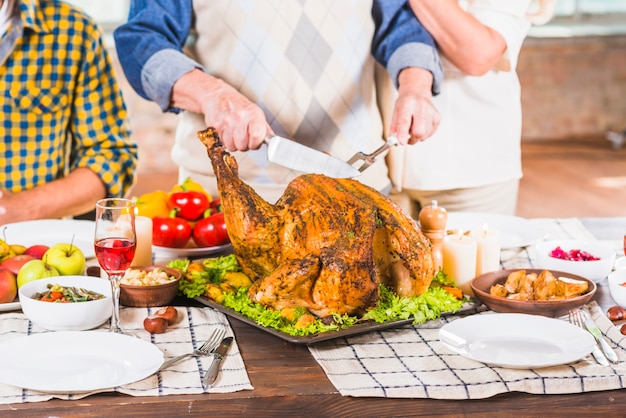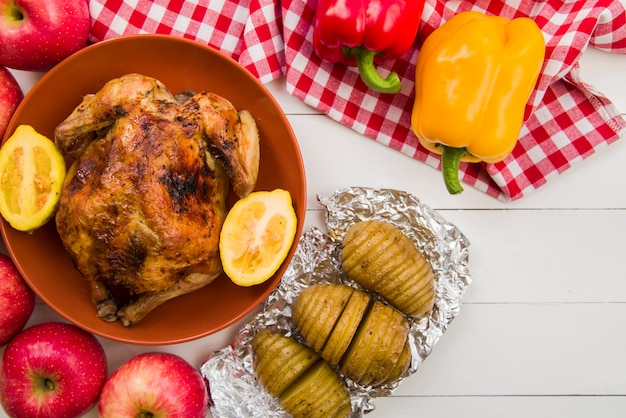The aroma of roasted turkey, the crackling of the skin, the laughter around the table – there’s nothing quite like a perfectly cooked turkey to bring people together. But getting that bird just right can be a bit daunting, especially when it’s a hefty 20lb stuffed turkey. Fear not, my fellow food enthusiasts, because today we’re diving deep into the art of turkey roasting, uncovering the secrets to achieving that golden-brown, juicy, and oh-so-flavorful masterpiece.
Part 1: The Basics of Roasting a 20lb Stuffed Turkey

We’re dealing with a significant bird here, and when it’s stuffed, the complexity increases. It's not just about the turkey itself, but also about ensuring the stuffing reaches a safe internal temperature.
1.1 The Importance of Temperature: It's Not Just a Number
Remember that 165°F (74°C) number? That’s the magic temperature we’re aiming for, both in the turkey’s thickest part (the thigh) and in the stuffing. This is crucial because it eliminates any potential bacterial nasties that might be lurking.
1.2 Unstuffed vs. Stuffed: The Time Difference
A 20lb unstuffed turkey will generally take 3-4 hours to cook. But remember, each bird is unique, and factors like size, shape, and your oven can impact the time. Now, for the stuffed turkey, we need to add some extra cooking time to ensure the stuffing reaches that 165°F (74°C) mark. Expect to add an additional 30-45 minutes, bringing the total cooking time for a 20lb stuffed turkey to around 3.5-4.5 hours.
Part 2: Factors Affecting Cooking Time: It's Not Just About the Oven

While that 3.5-4.5 hour estimate is a good starting point, several factors can influence the exact cooking time.
2.1 The Oven's Temperature: A Matter of Degrees
Most recipes recommend 325°F (163°C). However, some prefer a lower temperature like 300°F (149°C). This can lead to more even cooking and prevents drying, but it will also take longer.
2.2 The Turkey's Size and Shape: Not All Birds Are Created Equal
A large, broad-chested turkey will need more time than a smaller, slender one. Think of it like a big roast – it needs longer to cook through.
2.3 The Turkey's Internal Temperature: The Ultimate Decider
This is the most important factor. You can only truly know the turkey is done when you check the internal temperature with a meat thermometer. No matter what the recipe says, the thermometer will tell you the true story.
2.4 Oven Type: A Variable You Can't Ignore
Ovens aren't all created equal. Some run hotter, others run colder. This might require you to adjust the cooking time slightly.
Part 3: How to Ensure a Perfectly Cooked Turkey: Beyond Just Checking the Temperature

Reaching that 165°F (74°C) is crucial, but it’s not the only indicator.
3.1 Visual Clues: The Turkey's Appearance Can Tell You a Tale
The skin should be a beautiful golden brown, with a slightly crispy texture. The juices running from the turkey should be clear, not pink or bloody.
3.2 The Leg Test: A Quick and Reliable Check
If the leg wiggles easily, the turkey is likely cooked through. If it feels stiff, it needs more time.
3.3 Checking the Stuffing: Don't Forget About the Inside
Always check the stuffing's temperature with a meat thermometer. It, too, needs to hit 165°F (74°C). If it’s not quite there, gently pull it out and bake it separately in a dish.
Part 4: Avoiding Dry Turkey: The Enemy of a Delicious Feast
Dry turkey is a tragedy – nobody wants that! Here’s how to avoid it.
4.1 The Brine: A Moisture-Boosting Miracle
Brining is a game-changer. Soaking the turkey in a salt water solution for several hours helps retain moisture, resulting in a juicier bird.
4.2 Basting: A Simple Technique for a Huge Difference
Basting, pouring the drippings over the turkey while it’s roasting, helps keep the skin moist and prevents it from drying out. It's a simple act that pays off big time.
4.3 Resting the Turkey: Patience is a Virtue
Don't rush to carve! Letting the turkey rest for at least 20 minutes (30 is even better) allows the juices to redistribute, resulting in a more succulent and flavorful turkey.
Part 5: A Detailed Guide to Roasting a 20lb Stuffed Turkey: Step-by-Step Instructions
Now that we’ve covered the basics, let’s put it all together:
5.1 Preheat the Oven: Get That Temperature Up
Set your oven to 325°F (163°C).
5.2 Prepare the Turkey: Let It Come Up to Room Temperature
Take the turkey out of the fridge and let it rest for about 30 minutes. This helps ensure more even cooking.
5.3 Stuff the Turkey: Packing it Tightly
Pack your stuffing into the turkey cavity, but don't overstuff it. You want the stuffing to cook evenly and safely.
5.4 Roast the Turkey: It's Time to Shine
Place the turkey in a roasting pan and roast for 3.5-4.5 hours, or until the internal temperature reaches 165°F (74°C) in both the thigh and the stuffing.
5.5 Check the Temperature: Regularly and Carefully
Use a meat thermometer to check the temperature every hour or so. This is especially important when you’re cooking a stuffed turkey.
5.6 Basting: For a Juicy, Golden-Brown Bird
Baste the turkey with the pan drippings every 30-45 minutes. This adds flavor and moisture to the skin.
5.7 Rest the Turkey: Let It Relax
Once the turkey is cooked, remove it from the oven and let it rest for at least 20 minutes.
Part 6: What if You Don't Have a Meat Thermometer?
Don't worry, it's not a deal-breaker. But it's best to buy one if you don't already own one.
6.1 Visual Clues and the Leg Test: When You Have to Rely on Other Indicators
Pay close attention to the visual clues (golden-brown skin, clear juices) and the leg test (easily wiggling leg).
6.2 Cooking Time as a Guide: A Starting Point for Your Oven
Use the estimated cooking times as a guideline, but remember that every oven and turkey is different.
6.3 Be Cautious: Err on the Side of Safety
If you’re unsure, it’s better to cook the turkey for a bit longer. Overcooked turkey is better than undercooked.
Part 7: Recipe for a Classic turkey stuffing: The Perfect Companion for Your Bird
Here's a simple and delicious recipe that's a classic for a reason:
7.1 Ingredients:
1 onion, chopped
2 celery stalks, chopped
1 cup dried bread cubes
1 cup chicken broth
1/2 cup chopped parsley
1/4 cup butter
1/2 teaspoon sage
1/4 teaspoon thyme
Salt and pepper to taste
7.2 Instructions:
1. Preheat oven to 350°F (175°C).
2. In a large skillet, sauté the onion and celery in butter until softened.
3. Add the bread cubes, chicken broth, parsley, sage, thyme, salt, and pepper to the skillet.
4. Stir well to combine and cook for 5 minutes, or until the bread cubes have absorbed most of the broth.
5. Transfer the stuffing to a baking dish and bake for 20 minutes, or until golden brown and heated through.
Part 8: Leftover Turkey: A Culinary Treasure
Don’t throw away those turkey leftovers! They are a treasure trove of flavor and potential for delicious meals.
8.1 turkey sandwiches: The Classic
Who doesn’t love a good turkey sandwich? Pile your leftover turkey on crusty bread, add some mustard and tomato, and enjoy.
8.2 turkey soup: Warm and Comforting
Add leftover turkey to a broth with vegetables, noodles, and a touch of cream for a hearty and flavorful soup.
8.3 turkey pot pie: A Hearty and Savory Dish
Use leftover turkey in a pot pie, combining it with a creamy sauce, vegetables, and a flaky pastry crust for a satisfying meal.
Part 9: FAQs: Your Burning Questions Answered
Got questions about roasting your turkey? I’ve got answers.
9.1 How do I know if the stuffing is cooked?
Check the internal temperature of the stuffing with a meat thermometer. It should be 165°F (74°C). If it's not cooked through, gently remove it from the turkey and bake it separately in a dish until it reaches the safe temperature.
9.2 Can I stuff the turkey the day before?
It's best to stuff the turkey right before roasting. Stuffing that sits at room temperature for extended periods can create a breeding ground for bacteria.
9.3 How long should I let the turkey rest?
Allow the turkey to rest for at least 20 minutes, but 30 minutes is ideal. This helps redistribute the juices and results in a more succulent bird.
9.4 What if my turkey is too big for my oven?
You can roast the breast and legs separately. Roast the breast for about an hour, then remove it and roast the legs for another 2-3 hours. Once both are cooked, let them rest together before carving.
9.5 What if my turkey is a bit dry?
You can add moisture back in by making a gravy from the pan drippings. Serving the turkey with a side of cranberry sauce or gravy can also help.
Part 10: A Final Word on Roasting a 20lb Stuffed Turkey: Embrace the Joy
Mastering the art of roasting a 20lb stuffed turkey takes practice and attention to detail. Don’t be afraid to experiment and find what works best for you. Most importantly, have fun! It’s about creating delicious memories and celebrating with loved ones. So, crank up the music, gather your ingredients, and get ready to roast a turkey that will be the star of your next feast!
Everyone is watching

Prime Rib Roast Cooking Time Chart: Per Pound Guide
Cooking TipsPrime rib roast. Just the name conjures images of lavish dinners, crackling fires, and hearty laughter. It’s ...

How Long to Bake Potatoes in the Oven (Perfect Every Time)
Cooking TipsBaked potatoes are a staple in my kitchen. They're incredibly versatile, delicious, and surprisingly easy to m...

Perfect Rice Every Time: The Ultimate Guide to Cooking Rice
Cooking TipsAs a self-proclaimed foodie, I've always been a bit obsessed with rice. It's the foundation of countless cuisi...

The Ultimate Guide to Cooking Asparagus: Tips, Techniques, and Recipes
Cooking TipsAsparagus. The mere mention of this spring delicacy conjures up images of vibrant green spears, crisp and burs...

Ultimate Guide to Cooking the Perfect Thanksgiving Turkey
Cooking TipsThanksgiving. Just the word conjures up images of overflowing tables laden with delicious food, the scent of r...
